Summary
Transient forebrain ischemia produces a spatially and temporally selective pattern of neuronal degeneration in the hippocampal formation of the Mongolian gerbil. Ischemic neuronal death has been suggested to depend on the activation of excitatory hippocampal pathways that project to the vulnerable neurons. This idea was tested by examining the effect of a unilateral entorhinal cortical lesion or a unilateral knife cut lesion of intrahippocampal pathways on the neuropathology produced by 5 min of complete fore-brain ischemia. A prior lesion of either the ipsilateral entorhinal cortex or the mossy fiber and Schaffer collateral-commissural pathways partially prevented the destruction of CA1b pyramidal cells in most animals. It did not, however, reduce the extent of ischemic neuronal death in any other hippocampal subfield. Within area CA1b, an entorhinal lesion protected an average of 23% of the pyramidal cells and a transection of both mossy and Schaffer collateral-commissural fibers protected an average of 36.5%. CA1b pyramidal cells saved from ischemia-induced degeneration appeared clearly abnormal when stained with cresyl violet or by silver impregnation. It is suggested that lesions of excitatory pathways attenuate ischemic damage to area CA1b by directly or indirectly reducing the level of synaptic excitation onto the vulnerable neurons. However, only a relatively small percentage of hippocampal neurons can be protected by these lesions in the gerbil ischemia model and there is reason to believe that the neurons protected in this manner may not be electrophysiologically competent. Synaptic excitation therefore appears to play an important, but not an essential, role in this model of ischemic brain damage.
Similar content being viewed by others
References
Brierley JB, Graham DI (1984) Hypoxia and vascular disorders of the central nervous system. In: Adams JH Corsellis JAN, Duchen LW (eds) Greenfield's neuropathology. Edward Arnold, London, pp 125–207
Choi DW (1988) Calcium-mediated neurotoxicity: relationship to specific channel types and role in ischemic damage. Trends Neurosci 11:465–469
Crain BJ, Westerkam WD, Harrison AH, Nadler JV (1988) Selective neuronal death after transient forebrain ischemia in the Mongolian gerbil: a silver impregnation study. Neuroscience 27:387–402
Ito U, Spatz M, Walker JT, Klatzo I (1975) Experimental cerebral ischemia in Mongolian gerbils. 1. Light microscopic observations. Acta Neuropathol (Berl) 32:209–223
Johansen FF, Jorgensen MB, Diemer NH (1987) Colchicine degranulation of the dentate gyrus protects the hippocampus CA-1 region from ischemic damage. In: Hicks TP, Lodge D, McLennan H (eds) Excitatory amino acid transmission. AR Liss, New York, pp 241–244
Johansen FF, Jorgensen MB, Diemer NH (1987) Ischemiainduced delayed neuronal death in the CA-1 hippocampus is dependent on intact glutamatergic innervation. In: Hicks TP, Lodge D, McLennan H (eds) Excitatory amino transmission. AR Liss, New York, pp 245–248
Jorgensen MB, Johansen FF, Diemer NH (1987) Removal of the entorhinal cortex protects hippocampal CA-1 neurons from ischemic damage. Acta Neuropathol (Berl) 73:189–194
Kirino T (1982) Delayed neuronal death in the gerbil hippocampus following transient ischemia. Brain Res 239:57–69
Kirino T, Sano K (1984) Selective vulnerability in the gerbil hippocampus following transient ischemia. Acta Neuropathol (Berl) 62:201–208
Lasner TM, Crain BJ, Nadler JV (1987) Entorhinal cortical lesion partially prevents hippocampal cell death after transient forebrain ischemia in the gerbil. Soc neurosci Abstr 13:1498
Levy DE, Brierley JB, Plum F (1975) Ischaemic brain damage in the gerbil in the absence of “no-reflow”. J Neurol Neurosurg Psychiatry 38:1197–1205
Lynch GS, Matthews DA, Mosko S, Parks T, Cotman CW (1972) Induced acetylcholinesterase-rich layer in rat dentate gyrus following entorhinal lesions. Brain Res 42:311–318
Nadler JV, Evenson DA (1983) Use of excitatory amino acids to make axon-sparing lesions of the hypothalamus. Methods Enzymol 103:393–400
Okazaki MM, Nadler JV (1988) Protective effects of mossy fiber lesions against kainic acid-induced seizures and neuronal degeneration. Neuroscience 26:763–781
Onodera H, Sato G, Kogure K (1986) Lesions to Schaffer collaterals prevent ischemic death of CA1 pyramidal cells. Neurosci Lett 68:169–174
Ottersen OP, Storm-Mathisen J (1986) Excitatory amino acid pathways in the brain. In: Schwarcz R, Ben-Ari Y (eds) Excitatory amino acids and epilepsy. Plenum Press, New York, pp 263–284
Rothman SM, Olney JW (1986) Glutamate and the pathophysiology of hypoxic-ischemic brain damage. Ann Neurol 19:105–111
Steward O (1976) Topographic organization of the projections from the entorhinal area to the hippocampal formation of the rat. J Comp Neurol 167:285–314
Steward O, Scoville SA (1976) Cells of origin of entorhinal cortical afferents to the hippocampus and fascia dentata of the rat. J Comp Neurol 169:347–370
Suzuki R, Yamaguchi T, Li C-L, Klatzo I (1983) The effects of 5-minute ischemia in Monogolian gerbils. 2. Changes of spontaneous neuronal activity in cerebral cortex and CA1 sector of hippocampus. Acta Neuropathol (Berl) 60:217–222
Urban L, Neill K, Crain BJ, Nadler JV, Somjen GG (1988) Synaptic physiology of hippocampal area CA1 after transient forebrain ischemia in the gerbil. Soc Neurosci Abstr 14:185
Wieloch T (1986) Endogenous excitotoxins as possible mediators of ischemic and hypoglycemic brain damage. In: Schwarcz R, Ben-Ari Y (eds) Excitatory amino acids and epilepsy. Plenum Press, New York, pp 127–138
Wieloch T, Lindvall O, Blomqvist P, Gage FH (1985) Evidence for amelioration of ischaemic neuronal damage in the hippocampal formation by lesions of the perforant path. Neurol Res 7:24–26
Author information
Authors and Affiliations
Additional information
Supported by NIH Stroke Center grant NS 06233
Rights and permissions
About this article
Cite this article
Kaplan, T.M., Lasner, T.M., Nadler, J.V. et al. Lesions of excitatory pathways reduce hippocampal cell death after transient forebrain ischemia in the gerbil. Acta Neuropathol 78, 283–290 (1989). https://doi.org/10.1007/BF00687758
Received:
Accepted:
Issue Date:
DOI: https://doi.org/10.1007/BF00687758




